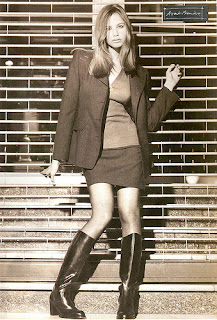 |
| Maxi image by vintspiration, via Flickr.com |
First, there was the "we don't follow your decadent western trends" theory. The Romanian authorities took every opportunity to point out the very worst aspects of western culture. Any Americn TV program or movie that emphasized corruption among police, the military, or federal officials was sure to be big hits there. Most of the TV programs broadcast in Romania were 15 to 20 years old, but when Dallas came out, it was on TV in Romania within a year. There wasn't a better propaganda vehicle for the Romanians to get their negative points across about American culture. So ensuring the clothing available in the country was nothing like American or European styles was another way to make a political statement.
Second, there was the "why waste fabric by making long skirts when short skirts will do" theory. There were plenty of sheep in Romania, so there was plenty of wool available, but Romania also sent nearly everything of quality produced in the country abroad, to earn hard currency. Conserving raw materials by minimizing the amount of fabric needed made good economic sense.
 |
| Mini image by fervent-adepte-de-la-mode via Flickr.com |
I didn't spend much time shopping for clothing in Romania, but I did make my way through the one department store in Iași. Later, in Moldova, I spent more time checking out what was available. In both places, I noticed that what was missing in both places was variety. There were clothes, racks and racks of clothes. But just like the aisles of canned tomatoes, entire lengths of aisles filled with just one brand and one size of canned tomatoes, the clothing on the racks were all the same. There were racks of the same style dress in the same purple print fabric, in all the sizes available. And then there were racks of an orange print dress.
Women in Romania turned this lack of variety into a way to make a statement anyway. In contrast to the west, where two women would never want to be seen at the same event wearing the same dress, Romanian women friends would pick out matching dresses, shoes, purses, hats, and anything else that could be seen as they walked down the street together, making a statement about their friendship and also their wealth which allowed them to buy what was newest in the market. Another case of not doing it the way the west does, but still doing what is done in the west - competing with one another.
People really are alike all around the world. It is just the details that differ.
No comments:
Post a Comment